VSpipe-GUI, an Interactive Graphical User Interface for Virtual Screening and Hit Selection
Abstract
1. Introduction
2. Results
2.1. VSpipe-GUI Features
2.2. Modules of VSpipe-GUI
2.2.1. Receptor Preparation Module
2.2.2. Compound Library Preparation Module
2.2.3. Docking Module
2.2.4. Filtering Results by Property Module
2.2.5. New Spatial Filtering (3D Filtering) Module
2.3. Benchmarking the Docking Step between VSpipe-GUI and VSpipe-CLI
3. Discussion
4. Materials and Methods
4.1. Programming Languages
4.2. Comparison of VSpipe-CLI and VSpipe-GUI
4.3. Visualization
4.4. Target Proteins and Ligands
4.5. Filtering the Results after the VS
4.6. Spatial Filtering
4.7. Docking Parameters for HCV NS3 Protease
Supplementary Materials
Author Contributions
Funding
Institutional Review Board Statement
Informed Consent Statement
Data Availability Statement
Acknowledgments
Conflicts of Interest
References
- Morris, G.M.; Huey, R.; Lindstrom, W.; Sanner, M.F.; Belew, R.K.; Goodsell, D.S.; Olson, A.J. AutoDock4 and AutoDockTools4: Automated Docking with Selective Receptor Flexibility. J. Comput. Chem. 2009, 30, 2785–2791. [Google Scholar] [CrossRef]
- Forli, S.; Huey, R.; Pique, M.E.; Sanner, M.F.; Goodsell, D.S.; Olson, A.J. Computational protein-ligand docking and virtual drug screening with the AutoDock suite. Nat. Protoc. 2016, 11, 905–919. [Google Scholar] [CrossRef]
- Seeliger, D.; de Groot, B.L. Ligand Docking and Binding Site Analysis with PyMOL and Autodock/Vina. J. Comput. Aided. Mol. Des. 2010, 24, 417–422. [Google Scholar] [CrossRef]
- Schrödinger, L.; DeLano, W. PyMOL. 2020. Available online: http://www.pymol.org/pymol (accessed on 4 July 2023).
- Allen, W.J.; Balius, T.E.; Mukherjee, S.; Brozell, S.R.; Moustakas, D.T.; Lang, P.T.; Case, D.A.; Kuntz, I.D.; Rizzo, R.C. DOCK 6: Impact of New Features and Current Docking Performance. J. Comput. Chem. 2015, 36, 1132–1156. [Google Scholar] [CrossRef]
- Friesner, R.A.; Banks, J.L.; Murphy, R.B.; Halgren, T.A.; Klicic, J.J.; Mainz, D.T.; Repasky, M.P.; Knoll, E.H.; Shelley, M.; Perry, J.K.; et al. Glide: A New Approach for Rapid, Accurate Docking and Scoring. 1. Method and Assessment of Docking Accuracy. J. Med. Chem. 2004, 47, 1739–1749. [Google Scholar] [CrossRef]
- Verdonk, M.L.; Cole, J.C.; Hartshorn, M.J.; Murray, C.W.; Taylor, R.D. Improved Protein-Ligand Docking Using GOLD. Proteins Struct. Funct. Bioinform. 2003, 52, 609–623. [Google Scholar] [CrossRef]
- Kramer, B.; Rarey, M.; Lengauer, T. Evaluation of the FLEXX Incremental Construction Algorithm for Protein—Ligand Docking. Proteins Struct. Funct. Bioinform. 1999, 37, 228–241. [Google Scholar] [CrossRef]
- Álvarez-Carretero, S.; Pavlopoulou, N.; Adams, J.; Gilsenan, J.; Tabernero, L. VSpipe, an Integrated Resource for Virtual Screening and Hit Selection: Applications to Protein Tyrosine Phospahatase Inhibition. Molecules 2018, 23, 353. [Google Scholar] [CrossRef] [PubMed]
- Trott, O.; Olson, A.J. AutoDock Vina: Improving the Speed and Accuracy of Docking with a New Scoring Function, Efficient Optimization, and Multithreading. J. Comput. Chem. 2010, 31, 455–461. [Google Scholar] [CrossRef] [PubMed]
- O’Boyle, N.M.; Banck, M.; James, C.A.; Morley, C.; Vandermeersch, T.; Hutchison, G.R. Open Babel: An Open Chemical Toolbox. J. Cheminform. 2011, 3, 33. [Google Scholar] [CrossRef] [PubMed]
- Lipinski, C.A. Drug-like Properties and the Causes of Poor Solubility and Poor Permeability. J. Pharmacol. Toxicol. Methods 2000, 44, 235–249. [Google Scholar] [CrossRef]
- Hopkins, A.L.; Groom, C.R.; Alex, A. Ligand Efficiency: A Useful Metric for Lead Selection. Drug Discov. Today 2004, 9, 430–431. [Google Scholar] [CrossRef] [PubMed]
- Hopkins, A.L.; Keserü, G.M.; Leeson, P.D.; Rees, D.C.; Reynolds, C.H. The Role of Ligand Efficiency Metrics in Drug Discovery. Nat. Rev. Drug Discov. 2014, 13, 105–121. [Google Scholar] [CrossRef] [PubMed]
- Abad-Zapatero, C.; Metz, J.T. Ligand Efficiency Indices as Guideposts for Drug Discovery. Drug Discov. Today 2005, 10, 464–469. [Google Scholar] [CrossRef]
- Abad-Zapatero, C. Ligand Efficiency Indices for Effective Drug Discovery. Expert Opin. Drug Discov. 2007, 2, 469–488. [Google Scholar] [CrossRef] [PubMed]
- Onyango, H.; Odhiambo, P.; Angwenyi, D.; Okoth, P. In Silico Identification of New Anti-SARS-CoV-2 Main Protease (Mpro) Molecules with Pharmacokinetic Properties from Natural Sources Using Molecular Dynamics (MD) Simulations and Hierarchical Virtual Screening. J. Trop. Med. 2022, 2022, 3697498. [Google Scholar] [CrossRef] [PubMed]
- Scott, J.; Sueiro-Olivares, M.; Thornton, B.P.; Owens, R.A.; Muhamadali, H.; Fortune-Grant, R.; Thomson, D.; Thomas, R.; Hollywood, K.; Doyle, S.; et al. Targeting Methionine Synthase in a Fungal Pathogen Causes a Metabolic Imbalance That Impacts Cell Energetics, Growth, and Virulence. mBio 2020, 11, e01985-20. [Google Scholar] [CrossRef]
- Adams, J.; Thornton, B.P.; Tabernero, L. A New Paradigm for KIM-PTP Drug Discovery: Identification of Allosteric Sites with Potential for Selective Inhibition Using Virtual Screening and LEI Analysis. Int. J. Mol. Sci. 2021, 22, 12206. [Google Scholar] [CrossRef]
- Thornton, B.P.; Johns, A.; Al-Shidhani, R.; Álvarez-Carretero, S.; Storer, I.S.R.; Bromley, M.J.; Tabernero, L. Identification of Functional and Druggable Sites in Aspergillus Fumigatus Essential Phosphatases by Virtual Screening. Int. J. Mol. Sci. 2019, 20, 4636. [Google Scholar] [CrossRef]
- Xing, Y.; Yang, R.; Yang, H.; Jiang, D.; Xu, L.; Feng, L. Investigation of the Potential Mechanism of the Shugan Xiaozhi Decoction for the Treatment of Nonalcoholic Fatty Liver Disease Based on Network Pharmacology and Molecular Docking. PeerJ 2022, 10, e14171. [Google Scholar] [CrossRef]
- Sussman, J.L.; Lin, D.; Jiang, J.; Manning, N.O.; Prilusky, J.; Ritter, O.; Abola, E.E. Protein Data Bank (PDB): Database of Three-Dimensional Structural Information of Biological Macromolecules. Acta Crystallogr. Sect. D Struct. Biol. 1998, 54, 1078–1084. [Google Scholar] [CrossRef]
- Romano, K.P.; Ali, A.; Aydin, C.; Soumana, D.; Özen, A.; Deveau, L.M.; Silver, C.; Cao, H.; Newton, A.; Petropoulos, C.J.; et al. The Molecular Basis of Drug Resistance against Hepatitis C Virus NS3/4A Protease Inhibitors. PLoS Pathog. 2012, 8, 22. [Google Scholar] [CrossRef] [PubMed]
- Ashraf, M.U.; Iman, K.; Khalid, M.F.; Salman, H.M.; Shafi, T.; Rafi, M.; Javaid, N.; Hussain, R.; Ahmad, F.; Shahzad-Ul-Hussan, S.; et al. Evolution of Efficacious Pangenotypic Hepatitis C Virus Therapies. Med. Res. Rev. 2019, 39, 1091–1136. [Google Scholar] [CrossRef] [PubMed]
- Ha, E.J.; Lwin, C.T.; Durrant, J.D. LigGrep: A Tool for Filtering Docked Poses to Improve Virtual-Screening Hit Rates. J. Cheminform. 2020, 12, 69. [Google Scholar] [CrossRef] [PubMed]
- Laskowski, R.A.; Swindells, M.B. LigPlot+: Multiple Ligand—Protein Interaction Diagrams for Drug Discovery. J. Chem. Inf. Model. 2011, 51, 2778–2786. [Google Scholar] [CrossRef]
- Soumana, D.I.; Kurt Yilmaz, N.; Prachanronarong, K.L.; Aydin, C.; Ali, A.; Schiffer, C.A. Structural and Thermodynamic Effects of Macrocyclization in HCV NS3/4A Inhibitor MK-5172. ACS Chem. Biol. 2016, 11, 900–909. [Google Scholar] [CrossRef] [PubMed]
- Summa, V.; Ludmerer, S.W.; McCauley, J.A.; Fandozzi, C.; Burlein, C.; Claudio, G.; Coleman, P.J.; DiMuzio, J.M.; Ferrara, M.; Di Filippo, M.; et al. MK-5172, a Selective Inhibitor of Hepatitis C Virus NS3/4a Protease with Broad Activity across Genotypes and Resistant Variants. Antimicrob. Agents Chemother. 2012, 56, 4161–4167. [Google Scholar] [CrossRef] [PubMed]
- Saalau-Bethell, S.M.; Woodhead, A.J.; Chessari, G.; Carr, M.G.; Coyle, J.; Graham, B.; Hiscock, S.D.; Murray, C.W.; Pathuri, P.; Rich, S.J.; et al. Discovery of an Allosteric Mechanism for the Regulation of HCV NS3 Protein Function. Nat. Chem. Biol. 2012, 8, 920–925. [Google Scholar] [CrossRef] [PubMed]
- Abian, O.; Vega, S.; Sancho, J.; Velazquez-Campoy, A. Allosteric Inhibitors of the NS3 Protease from the Hepatitis C Virus. PLoS ONE 2013, 8, e69773. [Google Scholar] [CrossRef]
- Xue, W.; Yang, Y.; Wang, X.; Liu, H.; Yao, X. Computational Study on the Inhibitor Binding Mode and Allosteric Regulation Mechanism in Hepatitis C Virus NS3/4A Protein. PLoS ONE 2014, 9, e87077. [Google Scholar] [CrossRef]
- Xue, W.; Ban, Y.; Liu, H.; Yao, X. Computational Study on the Drug Resistance Mechanism against HCV NS3/4A Protease Inhibitors Vaniprevir and MK-5172 by the Combination Use of Molecular Dynamics Simulation, Residue Interaction Network, and Substrate Envelope Analysis. J. Chem. Inf. Model. 2014, 54, 621–633. [Google Scholar] [CrossRef] [PubMed]
- Grayson, J.E. Python and Tkinter Programming; Manning Publications Co.: Greenwich, UK, 2000. [Google Scholar]
- Sobell, M.G. A Practical Guide to Ubuntu Linux; Pearson Education: London, UK, 2011. [Google Scholar]
- Bourne, P.E.; Weissig, H. Structural Bioinformatics; John Wiley & Sons: Hoboken, NJ, USA, 2005; pp. 1–649. [Google Scholar] [CrossRef]
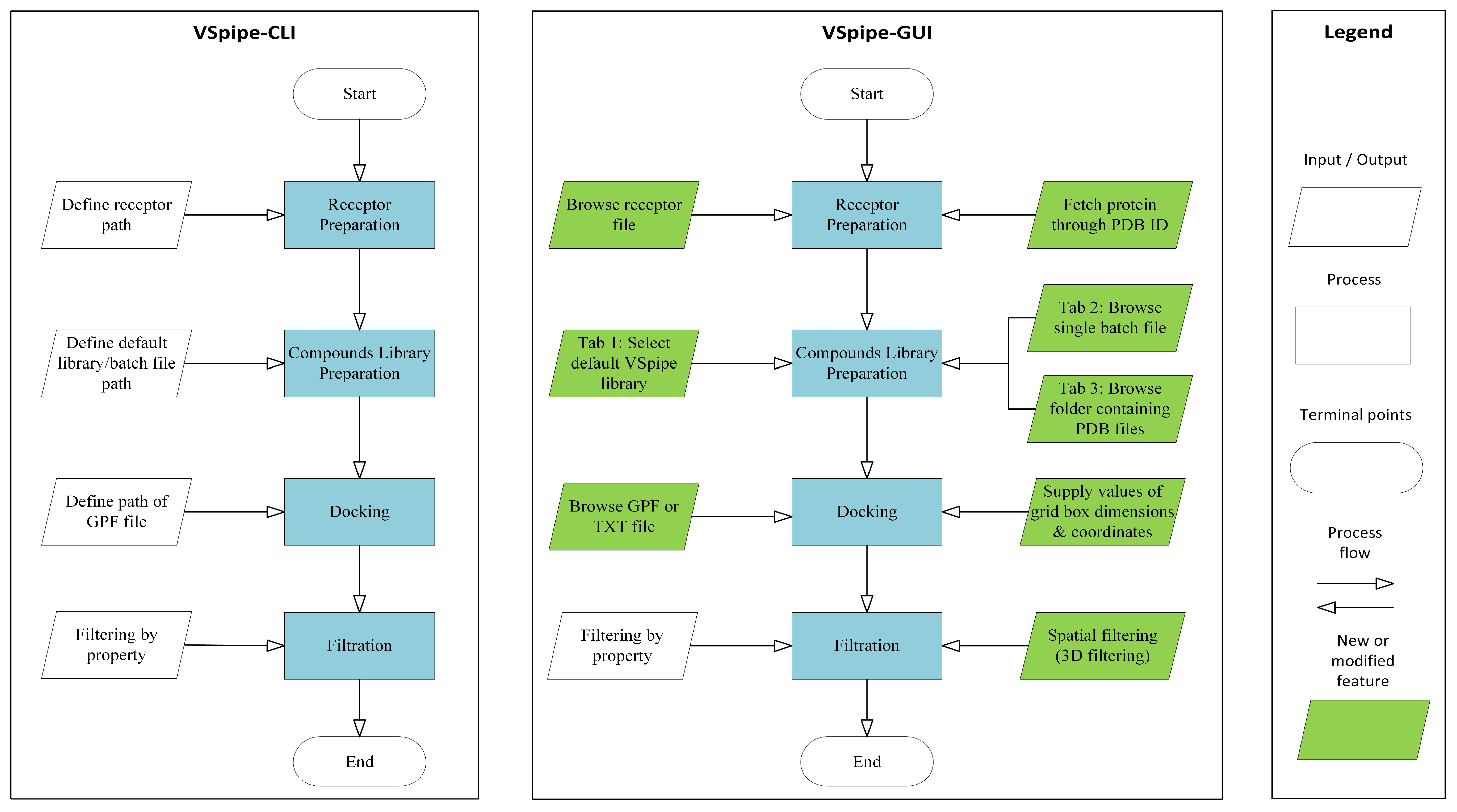
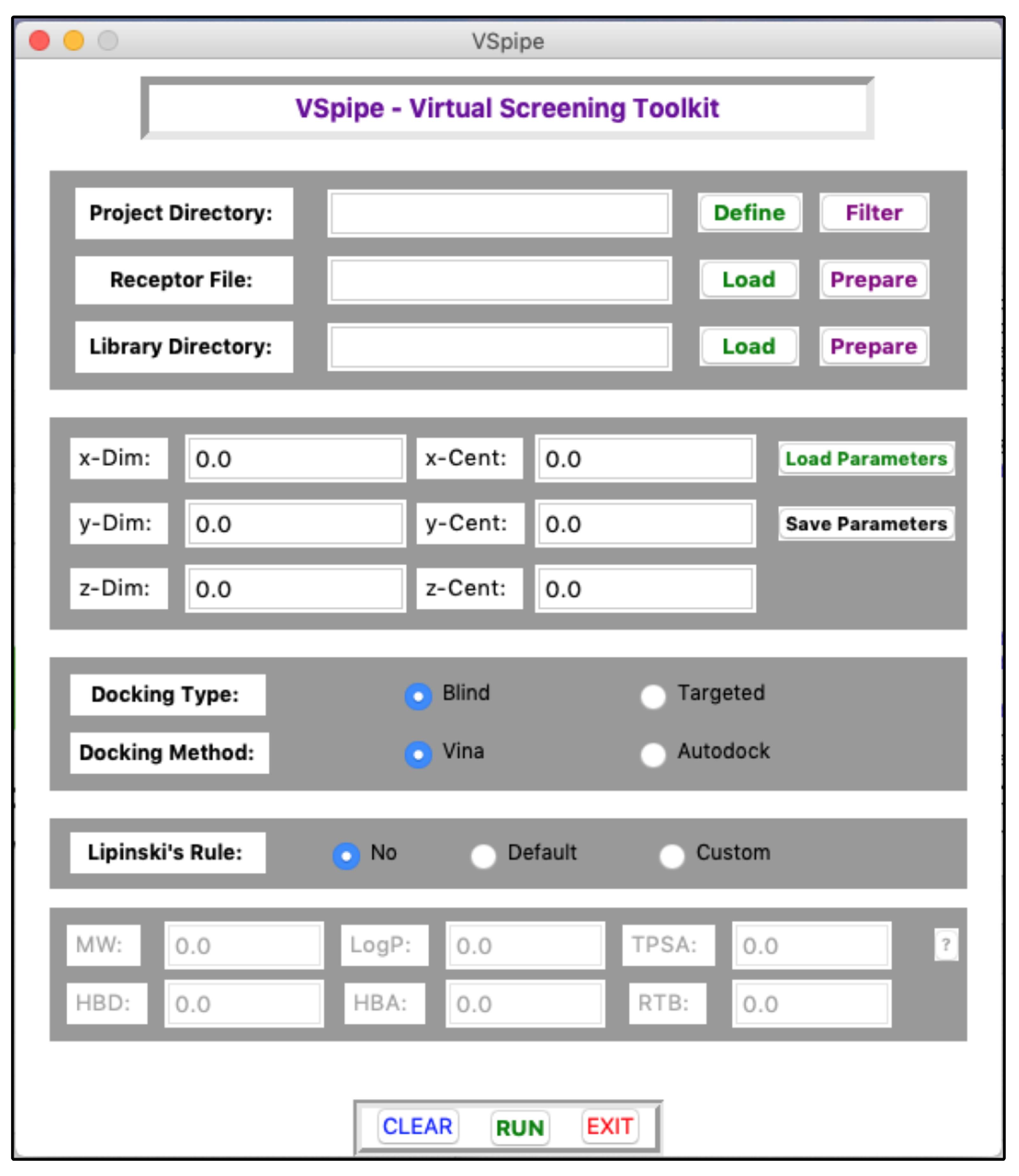
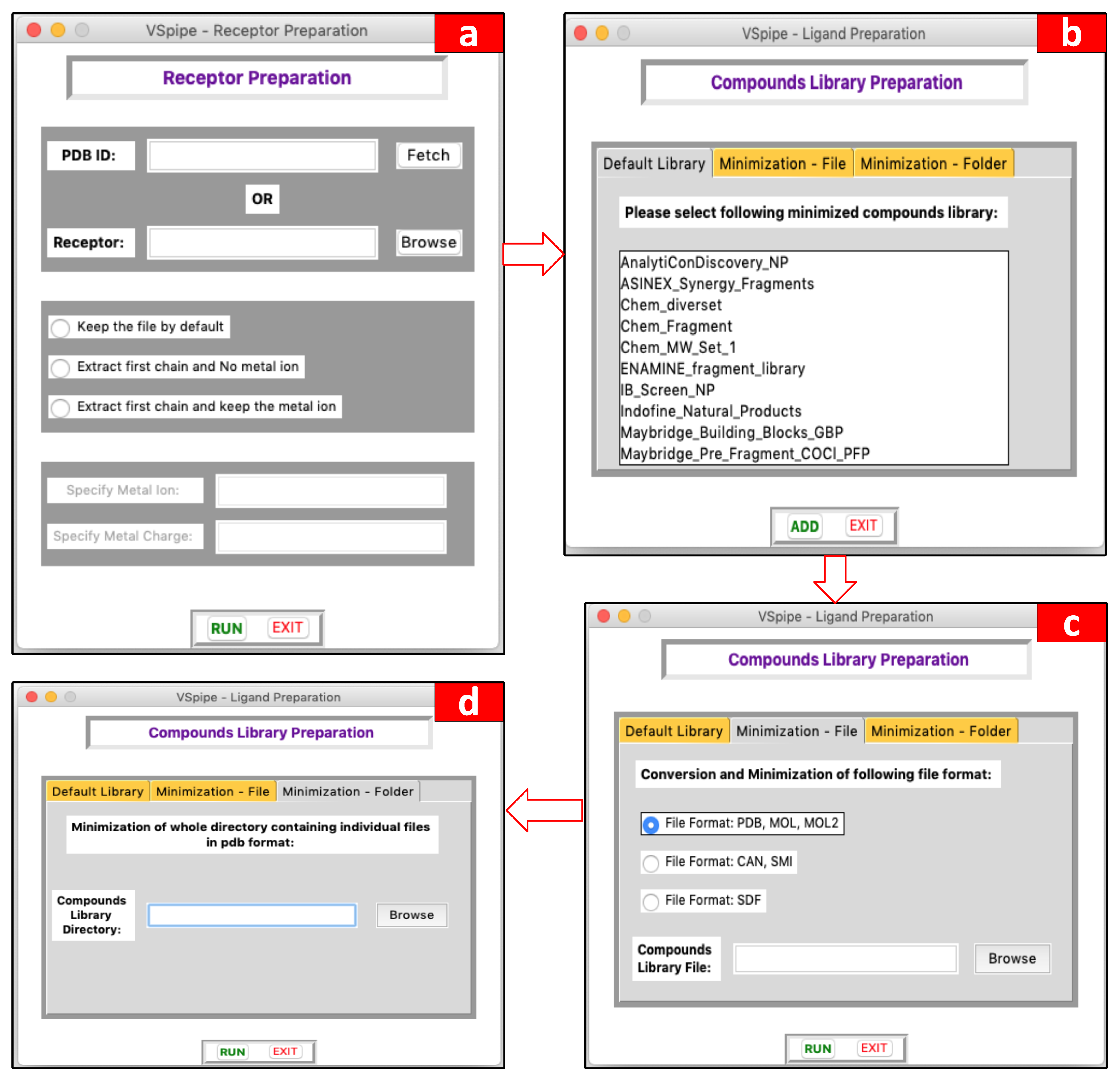
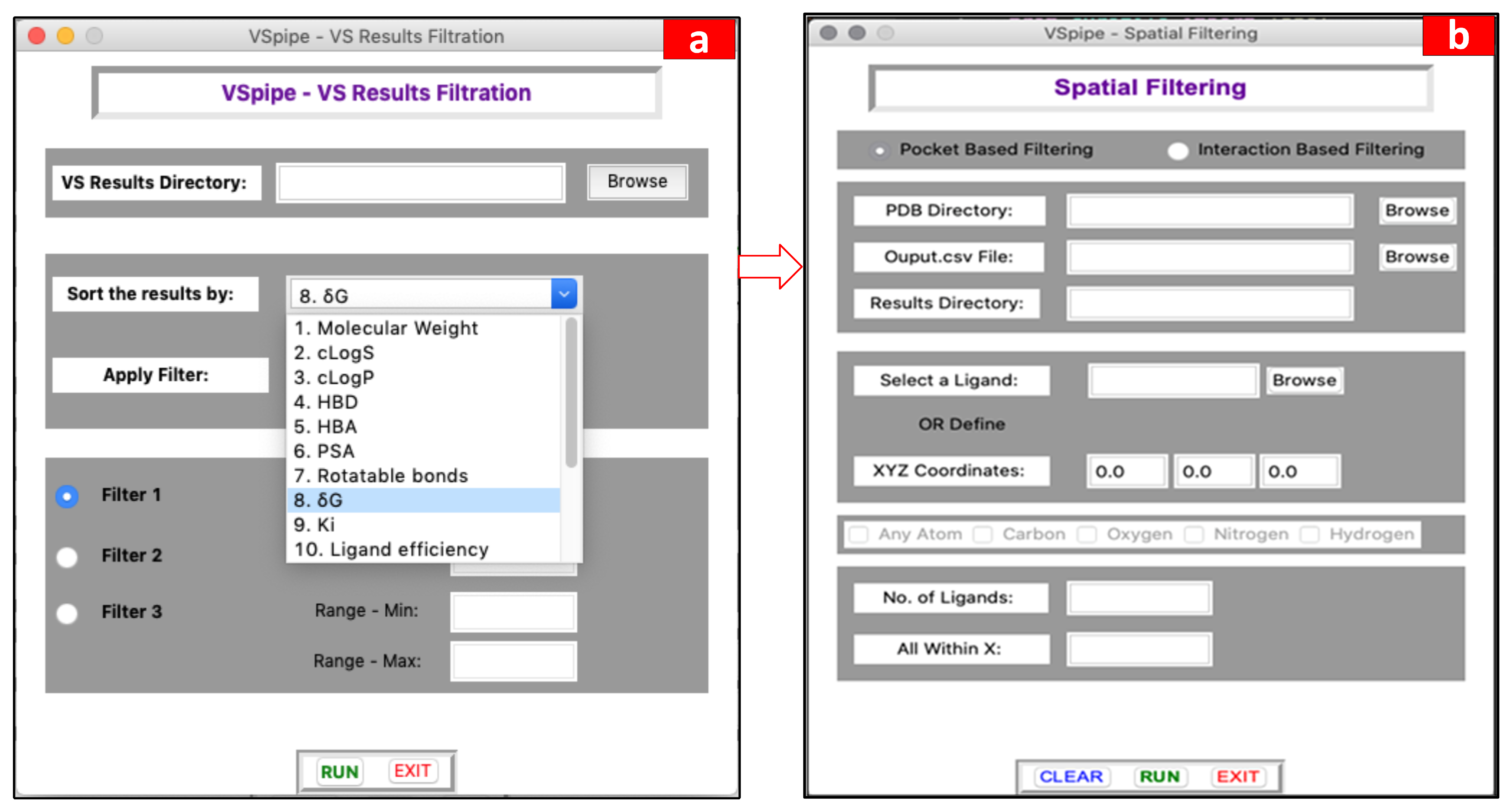

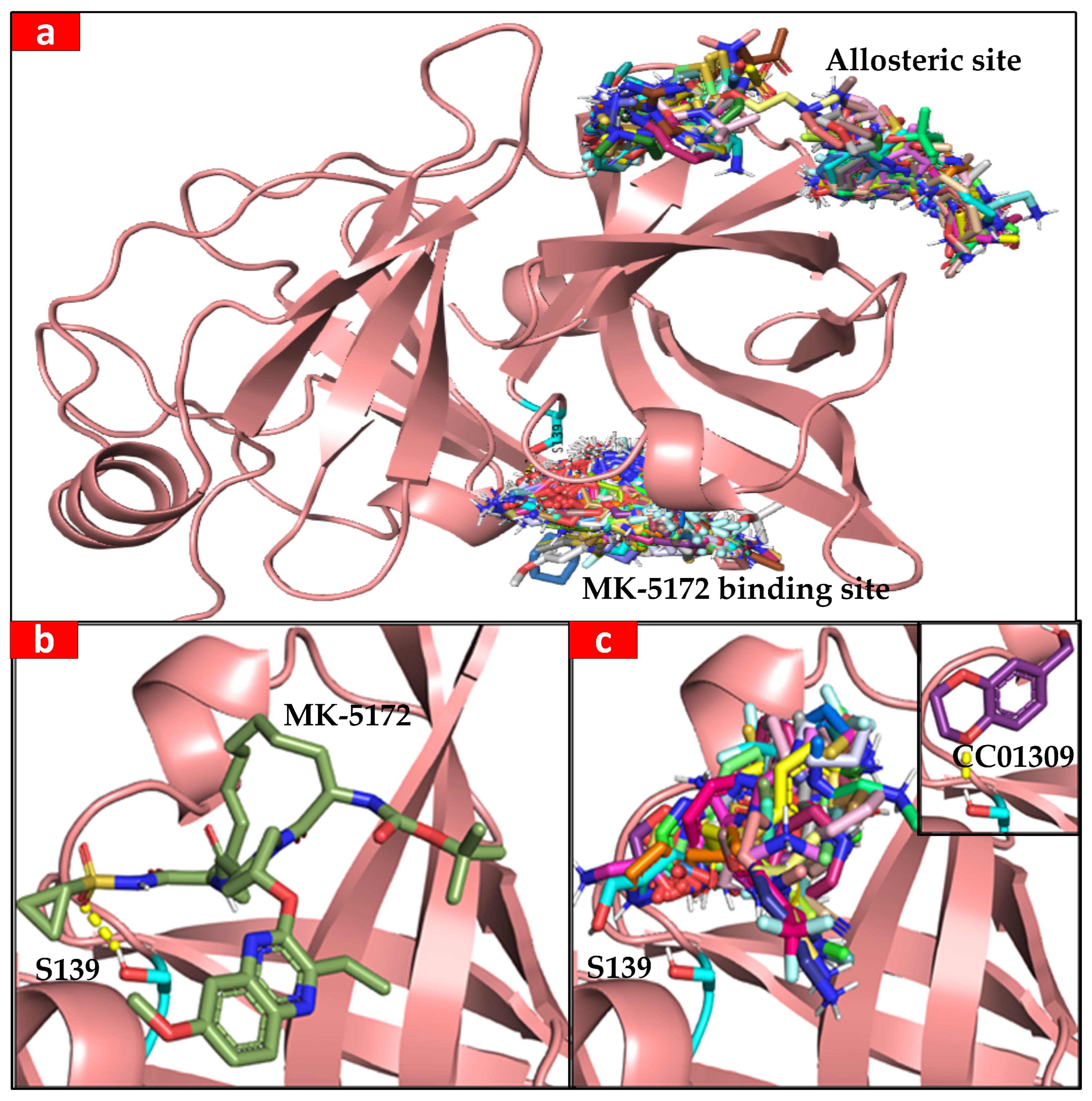
| Docking Software | Docking Time with VSpipe-CLI (hh:mm:ss) | Docking Time with VSpipe-GUI (hh:mm:ss) |
|---|---|---|
| 98 compounds | ||
| Vina 1.1.2 | 00:14:00 | 00:09:32 |
| AD4 4.2.6 | 01:16:26 | 01:23:10 |
| 500 compounds | ||
| Vina 1.1.2 | 01:28:26 | 00:49:18 |
| AD4 4.2.6 | 09:40:41 | 09:40:17 |
Disclaimer/Publisher’s Note: The statements, opinions and data contained in all publications are solely those of the individual author(s) and contributor(s) and not of MDPI and/or the editor(s). MDPI and/or the editor(s) disclaim responsibility for any injury to people or property resulting from any ideas, methods, instructions or products referred to in the content. |
© 2024 by the authors. Licensee MDPI, Basel, Switzerland. This article is an open access article distributed under the terms and conditions of the Creative Commons Attribution (CC BY) license (https://creativecommons.org/licenses/by/4.0/).
Share and Cite
Hussain, R.; Hackett, A.S.; Álvarez-Carretero, S.; Tabernero, L. VSpipe-GUI, an Interactive Graphical User Interface for Virtual Screening and Hit Selection. Int. J. Mol. Sci. 2024, 25, 2002. https://doi.org/10.3390/ijms25042002
Hussain R, Hackett AS, Álvarez-Carretero S, Tabernero L. VSpipe-GUI, an Interactive Graphical User Interface for Virtual Screening and Hit Selection. International Journal of Molecular Sciences. 2024; 25(4):2002. https://doi.org/10.3390/ijms25042002
Chicago/Turabian StyleHussain, Rashid, Andrew Scott Hackett, Sandra Álvarez-Carretero, and Lydia Tabernero. 2024. "VSpipe-GUI, an Interactive Graphical User Interface for Virtual Screening and Hit Selection" International Journal of Molecular Sciences 25, no. 4: 2002. https://doi.org/10.3390/ijms25042002
APA StyleHussain, R., Hackett, A. S., Álvarez-Carretero, S., & Tabernero, L. (2024). VSpipe-GUI, an Interactive Graphical User Interface for Virtual Screening and Hit Selection. International Journal of Molecular Sciences, 25(4), 2002. https://doi.org/10.3390/ijms25042002






